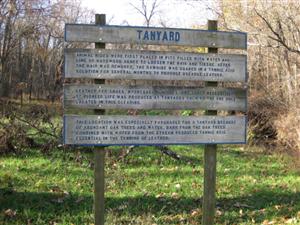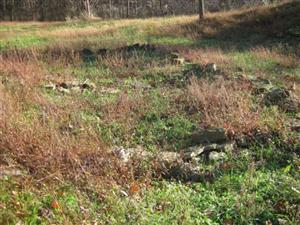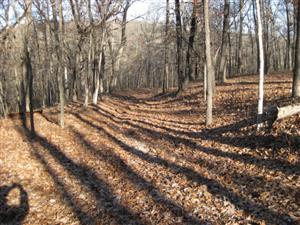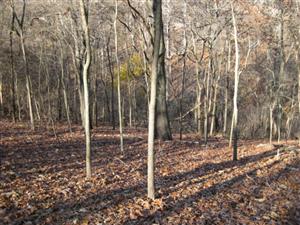The Tanyard
Tour Stop
Directions: The Tanyard [ Waypoint = N36 27.765 W94 00.856 ] is located about three quarters of a mile along the Wire Road to the north of Elkhorn Tavern. Continue walking north along the Wire Road. After approximately 0.75 miles you should see a large sign to the left (west) of the Wire Road. The text on this sign reads as follows:
“Animal hides were first placed in pits filled with water and lime or hardwood ashes to loosen the hair and tissue. After the hair was removed, the rawhide was soaked in a tannic acid solution for several months to produce usable leather.”
“Leather for shoes, harnesses, saddles, and other necessities for pioneer life was produced at tanyards such as the one once located in this clearing.”
“This location was especially favorable for a tanyard because of abundant oak trees and water. Bark from the oak trees combined with water from the stream produced tannic acid essential in the tanning of leather.”
Description: You are standing near where Union Major Weston first engaged troops from Price's division. Once Weston sent word to Brigadier General Samuel R. Curtis, Curtis would be slow to realize that the Confederates had outflanked him and gotten astride his supply lines back to Rolla, Missouri. Weston would work to move the Union supply wagons south to Pratt's Store and out of danger.
Major Weston was the Provost Marshall responsible for the Federal army's supply depot. As a precaution he had established a perimeter as he describes in his official report:
“On the evening previous to the conflict I had placed cavalry pickets on the Huntsville and on a cross-road leading into the Springfield and Bentonville road, supported by infantry. About 3 o'clock the morning of the engagement Private Welch, of Company M, Third Illinois Cavalry, while on duty near the Bentonville road, was captured by a party of rebel cavalry. While on the road to the rebels' camp he suddenly turned into, a by-road and fortunately escaped, minus his arms. In the mean time my pickets reported a force moving around on our left flank. I immediately ordered Company F, of my battalion, commanded by Capt. S. P. Barris, together with my two companies of cavalry, to go out into the cross-roads and reconnoiter the enemy, and ascertain, if possible, their strength. They proceeded to do as ordered, and on arriving near our picket ground they discovered a small force of rebel cavalry, who upon their approach fell back through a field and copse of timber.”
“I soon learned of a force approaching on the Cassville road. I immediately sent Company B, commanded by Capt. B. W. Fyan, down the road, with instructions to take them, supposing them to be the same scouting party before alluded to at the cross-roads. On arriving near the tannery Captain Fyan, discovering the force to be larger than before anticipated, sent back to be re-enforced. I immediately sent him Companies I and H, under command of Lieutenant Lyon, of Company H, to his assistance, at the same time ordering out the two remaining companies, A and F, to be in readiness, and sent Company K, Capt. J. R. Vanzant, with my train and 40 prisoners then in charge, to the extreme rear. At this time, receiving information that the enemy were on our left and steadily moving around to our right, I deployed the second platoon of Company A on the high hill to the left, and the first platoon, together with Company F, to the right, as skirmishers. My entire command being now engaged, I waited patiently for the result of what was yet to be. After waiting anxiously for an hour or more, I was somewhat relieved by the appearance of Acting Brigadier-General Carr and his division”
Union Brigadier General Samuel R. Curtis had reacted to Weston's reports concerning enemy activity and sent Colonel Eugene Carr north to Elkhorn Tavern with the 1st Brigade from Carr's 4th Division.
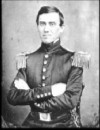 Confederate Colonel Henry Little later described their first encounter with the Federals near this location:
Confederate Colonel Henry Little later described their first encounter with the Federals near this location:
“The First [Second] Infantry, being at the head of our column was now ordered to advance in line by the hill-side to the right of the road, the Second Brigade, under General Slack, following; Gates cavalry next defiled by the left up the face of the hill afterwards occupied by our artillery. Here the cavalry made a prize of several forage wagons, returning laden to the camp of the enemy.”

